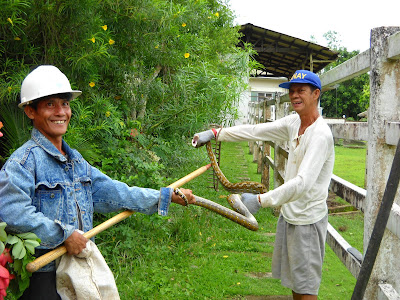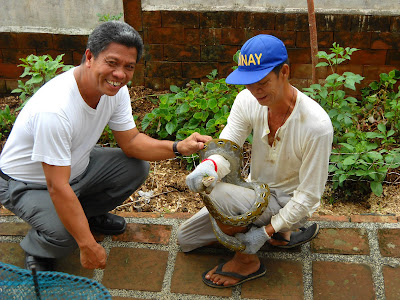I usually take a walk-about my farm to check on every single area. My walk will start from the main house garden, to the flower beds along the center pathway, to open field, checking drains, and looking out for the animals.
Many years ago, I learned to speak “duck” and observed the quiet attitude of my poultry whenever a storm, or monsoon rain was about to start. Usually, the chickens are everywhere, making their sweet clucking sounds as they forage through the grass and bushes. The ducks are often very playful once the rains soak the grounds, bringing a new generation of water snails which is their favorite food. I know the ducks have been out, by the number of snail shells I see empty, devoid of their luscious content. I don’t eat edible snails, or any kind of mollusk, even clams. Ducks are always wagging their tails, and quacking at each other, except when they know something dangerous lurks nearby.
This code of silence is clearly noticeable. I’ve never failed to enjoy an enthusiasm among the birds when there are breaks in the rain. When I walk around, I am welcomed by the shrieks of happy kingfishers, and the loud chirps of Malaysian Fantails hopping from the fountain where they bathe and drink, to the delicate quips of the nectar birds.
However, there was nothing but stone, cold, silence. I knew right away, this stillness meant there was a large snake somewhere. The ducks, chickens, even the birds of the sky see it, but I don’t. Suspicious, I ask our farm hand, Buhat to walk around the farm with me, and where there is an over abundance of weeds, and a plant I call “Corazon de Jesus,” I know that section of the farm has been unattended to.
Almost immediately, I saw the large elephant like ears of the “Corazon de Jesus” plant, which has a pink, heart shaped design in different sizes. The biggest leaves were against the wall, and it is very evident, the area beside the coffee bushes, lanzones, and “Dona Imelda” bushes, with their pink leaves, was overgrown. I had to have these plants cut back.
Buhat and I broke off some tall, red colored Ti plants to spread around the farm. I love their flame colored leaves, and I asked that these broken off stems be inserted in that area I wanted cleared of the “Corazon de Jesus “plant. This plant got its name from my Lola’s banishing this swamp plant because it attracts snakes. Snakes somehow like to coil themselves around it and just enjoy the coolness of the puddles of water during hot humid days. Sure enough, Buhat leaped back as he was just about to plunge a red Ti plant stem into the ground.
He saw a huge snake. He told me not to come near, as it was a large, and very bright colored snake. Buhat called for another farm hand to bring a long pole and help him catch the snake. When I heard “catch the snake,” in the vernacular, I knew it was not poisonous. I ran to the house to get my camera. I handed the camera to Esko and asked him to take photos because I did not want any large snake to chase me.
As soon as Esko made his way to the bushes, Soling leaped on the fence and started to scream. She said it was a huge snake, and it was hissing and opening its mouth, threatening the men.
Buhat was able to catch the snake, and I knew from the beautiful patterns, it was a boa constrictor. Buhat said the bigger male was caught a few weeks ago, and this smaller 7 footer must be the female.
Boa constrictors are quite colorful. The difference between pythons and boa constrictors is that pythons lay eggs, and boas give birth to live young. I’ve never seen boas that are as colorful as this one that my farm hands caught. The snake had patterns with gray, black, white and gold markings. I marveled at the beauty of something that could easily kill a large chicken, and probably helped her to a few of my pullets, wandering around foraging for food. This is one of the risks of having free range chickens running around the farm, especially during the rainy season where these snakes, stalk the smaller chickens, sleeping birds, and climb trees to catch bats eating ripening fruits at night.
The snake was set free many kilometers away, in another area. I wonder if this beautiful, bright colored snake would continue to evade people. A few exotic Chinese restaurants have been cashing in the latest craze of gecko napping going on, and the chefs at these oriental kitchens often serve snake, especially during the rainy season.
I immediately heard the noisy ducks clamor for their chance at playing in the rain, and the birds once again filled the sky with their joyful song.
Till the next snake hunt, hopefully not in the near future…I will avoid walking around the farm most especially just in slippers. Never go barefooted in wet grassy lawns. You never know what may be lurking about during the monsoon season!






